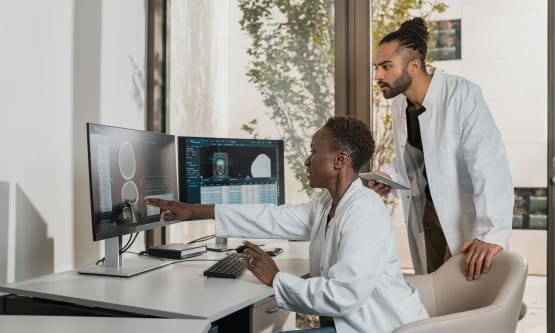Analyse this
- 15 March 2012

There was a certain tension at this year’s European Congress of Radiology. On the one hand, the giant meeting in Vienna heard about an exciting future for digital imaging, in which new IT systems would integrate radiologists ever more closely into medical workflows.
Yet, at the same time, there were concerns that these developments could lead to the increasing commoditisation of what has been, up to now, an extremely specialised service, and that this could erode both professionalism and standards.
The future of radiology reporting
Professor Charles Kahn from the Medical College of Milwaukee, told the congress that for all the advances in radiology over the past few decades, the workflow of radiologists has hardly changed – yet.
“Dictation has replaced handwriting,” he joked (although even this has yet to be the case everywhere). But otherwise, radiologists more or less do what they always did.
Recently, though, Professor Kahn argued that multimedia, key images, decision support, and information from guidelines have started to be incorporated into workflows.
As a result, some information, such as measurements, may be entered into reports automatically.
At the same time, the report may no longer be the end of the process – an acknowledgement of receipt of critical results may now be required from referring physicians, for example.
Professor Kahn said this not only made the process far more interactive, but meant that reports could be put to use for a variety of additional purposes.
After all, they contain valuable administrative information and potential indicators for benchmarking, productivity, and quality, as well as information for data mining in research and knowledge creation.
One avenue that has been explored to allow for the extraction of these types of information is structured reporting.
The benefits of structured reports
Professor Kahn went on to tell his audience that modularity, consistent ordering, and use of standard vocabularies – such as those developed by groups for chest imaging, for instance – are prerequisites for the automated extraction of information.
Coded elements can be linked to biomedical ontologies such as RadLex. The Radiological Society of North America has developed templates that show for various subspecialties how a good report can be done.
XML, meanwhile, is a set of rules for encoding documents that makes for both human and machine readable reports. Professor Kahn identified this and other standards as building blocks for creating a system that generates prompts for reporting and which helps to reduce errors.
Improvements in quality and patient safety are the ultimate goals of structured reporting, he concluded. And in the long run, it may even enable delivering lay medical information aimed at patients.
The downsides of commoditisation
However, Dr Richard Fitzgerald, consultant radiologist at the Royal Wolverhampton NHS Trust in England, effectively sounded a note of caution.
He told the congress that as health systems came under increasing demographic and financial pressure, trusts were putting pressure on their (tele-)radiologists to increase throughput, and looking for ways to obtain their services more cheaply.
He argued that this could shift radiology from being “a highly specific role to a general method of service delivery”, and warned that it could also raise serious issues about professionalism and standards.
For example, Dr Fitzgerald argued it was “absurd” that teleradiologists outside the UK do not have to register with the General Medical Council; and that the lack of clinical information sent to remote teleradiology services might lead to quality issues in reporting.
The ESR position is that teleradiology must be subject to the same levels of quality and safety as “standard” medical acts; service providers must be closely monitored, and accreditation criteria have to be harmonised across Europe.
Benefits of teleradiology
Continuing this theme, Dr Luis Donoso, executive director of the Diagnostic Center of the Corporation Sanitària Parc Tauli and director of the Center for Diagnostic Imaging of the Hospital Clinic of Barcelona, said he expected that organisational change would be a significant trend in coming years.
Chairing a session called “Radiology on the road”, he said he expected to see “the emergency of distributed imaging departments and/or collaborative networks of radiologists, as well as technological developments that will enable visualisation in new mobile devices.”
Donoso said that teleradiology can deliver significant benefits. It can overcome a shortage of locum staff and make more efficient use of healthcare resources, provide better working conditions for radiologists, and promote the extension of ICT-based processes in care services.
However, he stressed that: “We have to keep in mind that teleradiology is a medical art.”
“It’s not just sending images to get back a written report,” he said. It includes the whole spectrum of activities of a radiologist: ordering, scheduling, prioritising, handling images and clinical information, as well as reporting.
Change is coming
Some figures were put under this debate by a European survey of 368 radiologists, conducted at the end of 2011 with the support of the ESR.
It found that 65% already use teleradiology, with most revenue being generated in the UK and Germany.
Respondents said teleradiology was used to overcome temporary shortages, provide night cover and expert opinions. But it was also becoming part of regular workflow.
Commercial services used included e-marketplaces, commercial providers in the EU, partner healthcare institutions, tertiary centres, and commercial providers in the same country.
Respondents said the benefits of teleradiology included the ability to collaborate, improve efficiency, sub-specialise, and better distribute of workload.
But on the downside, they worried about a loss of control over business, reduced quality of reports, risks in urgent diagnoses, instability of jobs and income, poorer training, reduced quality of patient care, and loss of radiological skills.
The survey uncovered backing for clear national and EU regulations, mandatory quality assurance, further implementation of IHE profiles, mandatory teleradiology training, use of a “common” platform, mandatory duplicate readings, and the restriction of some services to radiologists only.
Cross-border teleradiology should be allowed only if controlled at EU level, one of the survey authors told the congress.
“Teleradiology is there to stay, and its impact will increase”; but a regulatory framework needs to be established; and the radiology, as well as the role of radiologists, will need to be refined.
Portals and devices
Out on the exhibition floor, vendors had their own take on these trends. For example, Peter Reimer, the general manager of imaging systems for Philips, was showing its IntelliSpace portal, which is part of the company’s ‘Imaging 2.0’ concept.
He said this delivers images, patient records, and radiology reports to workstations across a network, helping to accelerate diagnostic processes, reduce efforts, and cut costs.
Elsewhere, there was particular interest in mobile devices. Osman Ratib, a technology pioneer based at University College, London, said that while a hub used to be required to distribute PAS/RIS images to devices, it was now possible for small apps to support direct access.
Most PACS vendors have embraced this and made apps a feature of their web-based solutions, he added. Ratib demonstrated OsiriX, an open-source solution that allows for the distribution of images to portable devices, for querying and viewing.
Radiologists at UCL now use iPads displaying 3D images. Textbooks are now available as eBook apps with additional educational options. Ratib predicted that in five years every physician will demand such attractive devices, and that this will significantly impact workflow and clinical practice. IT infrastructures in hospitals will need to adapt, he warned.
Tweeting for the future
As if to underline his point, social media was a big feature of this year’s ECR. Onsite, large screens displayed messages delivered via Twitter and Facebook.
“It was helpful for me to receive messages, from colleagues, highlighting certain presentations or informal meetings,” explained a young radiologist from Slovakia.
Professor Andy Adam, a former president of ECR, told the 2012 event: “This is an exciting time with exciting prospects – [even though] some will have reservations.”



